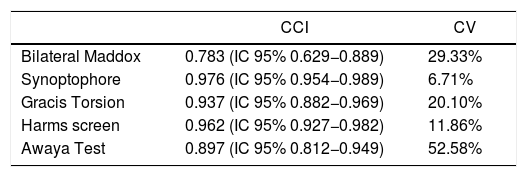To evaluate the reliability in the measurement of ocular torsion and the agreement of the following subjective methods: double Maddox test, synoptophore, Gracis torsionometer, Harms screen and Awaya cyclodeviation test.
MethodPatients with vertical strabismus acquired in adulthood were recruited and ocular torsion was measured with the 5 methods described on three occasions. As a gold standard test does not exist, the one that obtained the best repeatability data was chosen as the reference test.
Results25 patients were included in the study. The repeatability of each test was studied: double Maddox test (ICC = 0.783, CV = 29.33%), synoptophore (ICC = 0.976, CV = 6.71%), Gracis torsionometer (ICC = 0.937, CV = 20.10%), Harms screen (ICC = 0.962, CV = 11.86%) and Awaya test (ICC = 0.987, CV = 52.58%). The reference test to compare the agreement was the synoptophore. Statistically significant differences were found when comparing the ocular torsion ranges between the synoptophore and the Gracis torsionometer (p = 0.008) and between the synoptophore and the Awaya test (p = 0.02).
ConclusionsThe double Maddox test, the synoptophore, the Gracis torsionometer, and the Harms screen are reliable methods with good reproducibility indices. Among them, the synoptophore is the most consistent method. The Awaya test did not show good reliability. The bilateral Maddox test, the Gracis torsionometer, and the Harms screen were methods with good agreement with the synoptophore, which was determined as the reference test. The Awaya test did not show good agreement with the synoptophore.
Evaluar la fiabilidad en la medición de la torsión ocular y la concordancia de los siguientes métodos subjetivos: test de Maddox bilateral, sinoptóforo, torsionómetro de Gracis, pantalla de Harms y test de ciclodesviaciones de Awaya.
MétodoSe reclutaron pacientes con estrabismo vertical adquirido en la edad adulta y se realizó la medición de la torsión ocular con los 5 métodos descritos en tres ocasiones. Al no existir un gold standard en la medición subjetiva de la torsión ocular, se eligió como prueba de referencia aquella que obtuviera mejores datos de repetibilidad.
Resultados25 pacientes fueron incluidos en el estudio. Se estudió la repetibilidad de cada prueba: test de Maddox bilateral (CCI = 0,783, CV = 29,33%), sinoptóforo (CCI = 0,976, CV = 6,71%), torsionómetro de Gracis (CCI = 0,937, CV = 20,10%), pantalla de Harms (CCI = 0,962, CV = 11,86%) y test de Awaya (CCI = 0,987, CV = 52,58%). La prueba de referencia para comparar la concordancia fue el sinoptóforo. Se encontraron diferencias estadísticamente significativas al comparar los rangos de torsión ocular entre el sinoptóforo y el torsionómetro de Gracis (p = 0,008) y entre el sinoptóforo y el test de Awaya (p = 0,02).
ConclusionesEl test de Maddox bilateral, el sinoptóforo, el torsionómetro de Gracis, y la pantalla de Harms son métodos fiables con buenos índices de reproducibilidad. Entre ellos el sinoptóforo es el método más consistente. El test de Awaya no demostró buena fiabilidad. El test de Maddox bilateral, el torsionómetro de Gracis, y la pantalla de Harms fueron métodos con buena concordancia con el sinoptóforo, que se determinó como test de referencia. El test de Awaya no demostró buena concordancia con el sinoptóforo.












